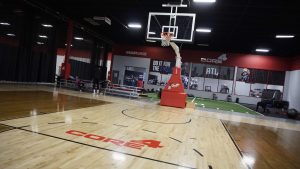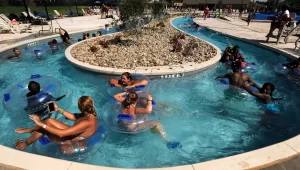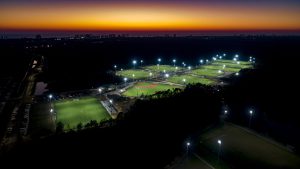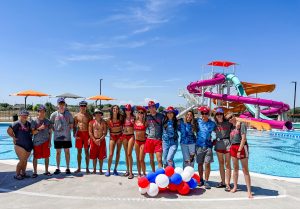Your roadmap to obtaining development funding for a sports complex project.
The ribbon cutting for a new sports complex represents a momentous occasion for any community. It also underscores an important story about how venues come to life. All sports complex development projects involve a tremendous investment of time, effort and energy to secure the necessary financial resources and support from the key stakeholders and decision makers that represent public and private sector partners. Obtaining funding for a sports complex requires a shared vision for how the venue will serve the community around it, a clear definition of success, detailed financial forecasting, economic impact analysis, and a facility program plan. It also requires the ability to package and convey this information in a way that inspires potential investors to action.
At the Sports Facilities Companies, we’ve guided thousands of communities through all aspects of facility development, including the development funding process. Based on our experiences, we have identified a number of best practices and guidelines for successfully navigating the project funding phase. Here are a few items to consider:
Download our free Sports Tourism Guide
Obtaining Funding for a Sports Complex Development Project is Not One Size Fits All
Procuring funding for a sports venue is not as simple as approaching a wealthy benefactor or a financial institution. Every project is different, and the capital stack can come together in a number of different ways depending on the facility ownership structure and each owner’s goals.
Below and throughout this article, we will highlight four distinctive ownership types. The information provided reflects the typical ownership objectives and traditional interests and resources that each can bring to the table.
Common Ownership Objectives for a Sports Complex:
Public Sector (City, County, Region):
To improve the quality of life in the local community and improve health, social, and economic outcomes for the area represented and/or to create a sports destination for economic development, tourism-generated dollars, and placemaking.
Educational Institutions
To improve the quality of education and the student experience, attract new students, engage with the surrounding community through sports, or supported educational initiative platforms, like the promotion of sports management or sports medicine.
Private Sector (Corporations or Organizations)
To build social capital within the community, by building brand awareness and engaging in meaningful marketing initiatives that drive employee and customer engagement as well as a direct return on investment.
Medical Institutions
To improve health outcomes, build brand equity and driving preference, positioning the institution as a distinctive healthcare entity through purpose-driven initiatives that drive both direct and downstream revenues within the surrounding community.
What types of funding can be utilized when developing a sports complex?
Based on ownership types, different methods of project funding will likely be available.
Public Sector
Funding available to public sector entities include general obligation debt or bonds, initiating legislative measures, and/or the creation of a non-profit development corporation to secure tax-free bonds.
Medical Institutions (Private Sector)
Increasingly, a number of medical institutions throughout the country are engaging in public-private partnerships and participating in other public and private incentive programs when developing facilities.
Educational Institutions (Private Sector)
Educational institutions often utilize philanthropic fundraising, traditional debt, direct cash investments, and tax-free bonds when funding sports venue projects.
The Sports Complex Development Funding Process
During the finance phase, well-managed projects use detailed analysis and reporting as tools and as an invitation for decision-makers to collaborate on an approach to funding.
These include:
• Market feasibility analysis
• Pro Forma and cash flow forecast
• Economic impact report
• Facility design and site plans
• Architectural renderings
Once these documents are produced, they are used to align potential investors on the funding approach that’s most advantageous for the ownership group.
At the SF Companies, our process for garnering development funding for sports complex projects is called Funding Development Support Services and is led by a team of experts that include development, finance, legal and other advisors. Through FDSS, we transition your vision from the feasibility phase to project funding, financing and strategic partnership development phase. Below are a few of the steps that are included in the FDSS process.
Funding Development Support Services at a Glance
The FDSS process is customized to the needs of each client through some of the steps below:
Development Team Planning Session 1
In this first session, our development advisors, help to refine your vision for the project through discussions about the facility program plan, Pro Forma, site selection, destination qualifiers, potential partners, and the project timeline. A detailed communication plan is established as a result of this session.
Facility Program and Financial Pro Forma Development
In this phase, an institutional-grade Financial Pro Forma and program plan is developed and reviewed, along with an economic impact analysis as well as current and future program facility utilization information. Initial partner/stakeholder engagement is also mapped out at this point and early input into the venue planning and facility design process is also initiated.
Development Team Planning Session 2
This phase represents a major step forward in the process of obtaining funding and includes final site tours and evaluations as well as final reviews of the Facility Program Plan and the operational projections. The project plan and timeline, the partnership development strategy, and the general funding plan are also discussed and refined during this session.
Stakeholder/ Investor Deck Development
This phase includes the finalization of the Architect Master Site Plan and Design and the Project Identity Narrative, which includes 3D renderings of the new facility. These items are used to develop a compelling presentation deck that can be tailored to different audiences.
Stakeholder, Funding and Major-Project Partner Engagement
This step includes in-market presentations and introductory meetings with the potential development and funding partners who are likely to engage in the process of getting the project funded. Initial Memorandum of Understanding (MOU) agreements are drafted and help to ensure alignment on the approach with prospective partners during this time as well.
Negotiations and Funding
In this final step, our FDSS team conducts presentations to funding sources as well as lead negotiations and the finalization of partnership agreements and/or MOU’s.






